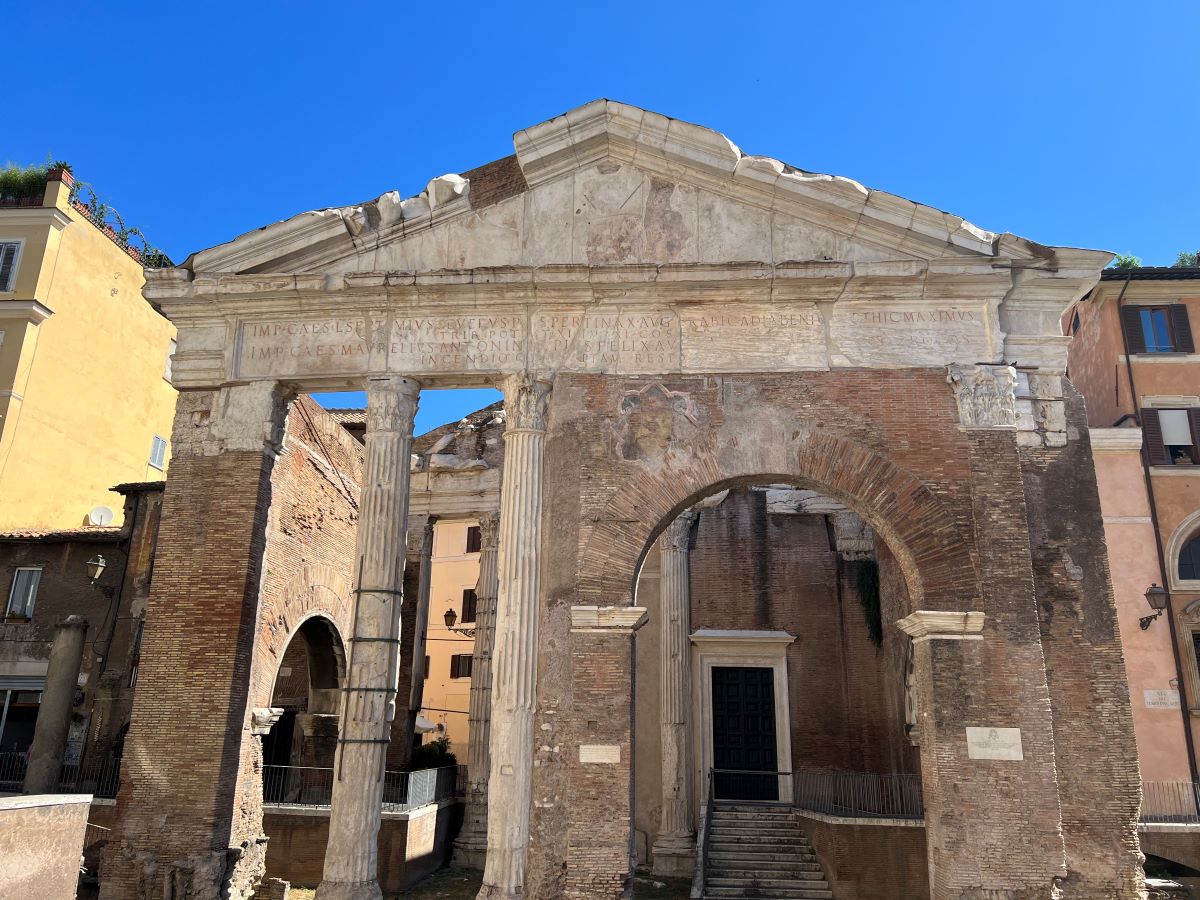
A mini-Colosseum worth visiting – get your camera ready.
The Teatro di Marcello was an ancient open-air theatre in Rome, and was one of the empire’s largest entertainment venues holding up to 20,000 spectators. Today, tourists visit the outside structure of the Teatro di Marcellous which offers a glimpse of the grandeur of Ancient Rome.
There are several posts with information next to the surrounding attractions which gives you the chance to learn about the history of this magnificent place.
The Teatro di Marcello is not the Colosseum!

Teatro di Marcello. Rome, Italy. Credit: Carry on Caro
It’s easy for tourists to confuse the Teatro di Marcello with the Colosseum. But there are some major differences.
- The Teatro di Marcello was built almost a century before the Colosseum.
- The Colosseum amphitheater forms a complete circle while the Teatro di Marcello is the typical semicircle seen through the ancient world.
- The Colosseum is much larger, holding more than double the spectators.
The Teatro di Marcello was originally planned to be developed by Julius Cesar. Since ancient times, the spot was planned for stage performances, and developing a formal structure was part of Cesar’s to improve public life after years of political turmoil.
The construction of the temple was resumed after Augustus took power and was crowned the first Roman emperor. In 17 BC, the building was already partially completed and used for the celebration of the ludi saeculares; however the building was not to be completed until several years later – either 13 or 11 BC.
Unfortunately, the Teatro di Marcello’s third tier was lost in Medieval reconstruction, but you can still see the classic ornamental Doric and Ionic columns on the lower tiers. Given that you can only experience the Teatro di Marcello from outside, make sure you wear sun protection – the sun can be brutal in Rome during the summer months. Also, I would plan to visit in the early morning or late afternoon.

Teatro di Marcello. Rome, Italy. Credit: Carry on Caro
Featured tours worth taking
Other attractions worth visiting
Portico d’Ottavia: Also worth seeing is the Porticus Octaviae (Portico d’Ottavia) which is located close to the Teatro di Marcello. Built in by Augustus in 27 BC, it aimed to enclose the temples of Jupiter Stator and Juno Regina. This structure was damaged through the centuries enduring both fires and earthquakes. In the Middle Ages, a fish market and a church were built on the ruins of the Portico d’Ottavia.

The Temple of Apollo: The Temple of Apollo was originally built in 431 BC, just as the Republic began to have ambitions beyond its regional boarders, and has been rebuilt several times since. Built to honor the god of prophecy, healing, and the arts in both the Greek and Roman worlds, the temple was a key element of the city’s landscape.
In fact, it was the only temple dedicated to the god until imperial times. There are 3 white Corinthian columns which were re-erected in the 1940’s that you can observe today; these columns form the now iconic image of the temple. As a temple to Apollo, the site itself has had as many names as the god himself, previously known as the Apollinar (“That which belongs to Apollo”) and the temple of Apollo Medicus (as the god was heavily associated with medical miracles).

Teatro di Marcello. Rome, Italy. Credit: Carry on Caro
How to get to the Teatro di Marcello
The theater can be found on Via del Teatro di Marcello. The Teatro di Marcello is located near the banks of the Tiber River and east of Rome’s Jewish Ghetto through the Portico d’Ottavia. You can access it via the metro stop Colosseo.
Visiting the Teatro di Marcello is a great opportunity to visit other nearby attractions:
- Capitoline Hill – 13-minute walk
- Piazza del Campidoglio – 13-minute walk
- Monument to Victor Emmanuel II – 12-minute walk
- Colosseum -25-minute walk
- Foro Romano – 15-minute walk
- Jewish Ghetto – 7-minute walk
- Largo di Torre Argentina – 12-minute walk
Admission fee
Surprisingly, there is no admission fee to visit the Teatro di Marcello, finally a budget-friendly place to visit in Rome!
Concerts at the Teatro di Marcello
From June until early October you can attend classical music concerts by the ruins of Teatro Marcello. Both emerging as well as established artists will perform at this location. You’ll have an architectural marvel as a backdrop that you won’t forget!
We are part of several affiliate programs including Amazon and Viator which means that we will earn a small commission at no extra cost to you if you make a purchase through the links included in this post.
